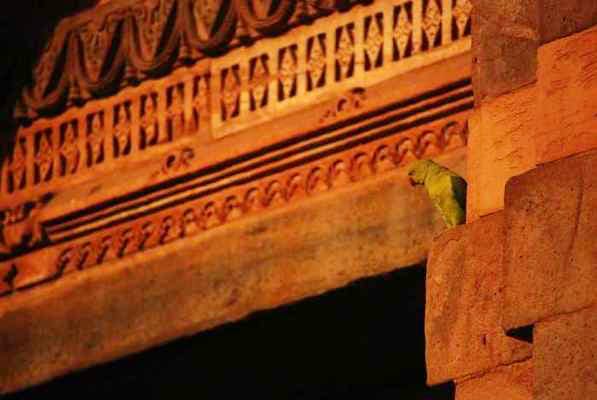By Mohd. Salman
November has come, and the weather’s just right for some time to be spent outdoors. In the last article, you read about some common, yet fascinating avian residents of the capital. Here’s a list of five more of Delhi’s finest.
Common Myna |

Referred to as a ‘bad-luck’ bird by some for reasons I do not know, this little yellow-footed and beaked bird is a fixture of the Indian landscape. Adapted perfectly to live alongside humans, these are the birds, above all others, that make those raucous calls you hear while walking past the park, through school or college, or driving along a well-treed avenue. Amid the usual black, grey and brown that we associate with ‘common’ birds, mynas are a welcome burst of colour.
Roseringed Parakeet |

Now this is one bird so many of us had {or still have} as a pet. The humble tota is a bird that flies free by the thousands all over the Indian landscape. Little bands fly past all the time in urban and rural skies, particularly in the mornings and evenings. They are the bane of fruit-growers, though, owing to their habit of wasting more than they eat. Another really great place to spot them is in city parks, where visitors leave food for all the birds and squirrels in the vicinity. When you’ve spent time looking at them, you realise that they are better outside those cages we often see them in.
A word to the wise, though: caged parakeets are bred in captivity, they are too weak to fly. Freeing them out of nobility helps only the neighbourhood cat.
Shikra |

The phonetic impact of a name does much to establish the nature of a person, creature or object. This bird, a roughly pigeon-sized blue hawk, is known to science as accipiter badius. A rather villainous name that also conveys a sense of speed. This is the resident flying hunter of our cities, a very dangerous bird for those that constitute its prey. Its short wings are just perfect to fly quick through dense foliage, and its attacks are sudden, the prey {smaller birds, rodents} swiftly swooped up and carried away, leaving screaming bird-calls in its wake. Females are larger, a duller brown in colour. The shikra is found in the better-wooded parts of the city, and needs to be looked for, patiently, and is invariably a rewarding bird to sight.
Jungle Babbler |

No mention of the shikra is complete for me if I do not speak of these guys. Also known as the ‘Seven Sisters’, the perpetual image of these birds is of a fat brown ball with eyes and a beak, and a tail stuck hurriedly at the rear, scampering about the environs in gangs of five or seven, an unruly mob pushing squirrels and sparrows aside at common feeding grounds. The ‘babble’ is a telling feature… the noise will tell you that this is indeed the bird you were looking for, when you see it in a garden, near a chai-wallah’s stall or at one of the city’s sanctuaries. In a world where mothers tell their children a hundred things to do so that they are out of trouble and safe from a spanking, jungle babblers are like the petulant kids who are always asking for it. And they get it, too. On many walks I have come across the sounds of babblers making merry, their location broadcast for all and sundry, only to hear sudden shrieks and a passing sight of a shikra making off with one of their number.
Whitethroated Kingfisher |

Two articles down, and no peacocks yet? Nope. The national bird’s being saved for the next article in this series. Meanwhile, let’s talk of another really amazing bird that is commoner than we believe, and leaves an incredible impression when it is seen.
The Whitethroated Kingfisher brings a spot of cheer whenever seen. It is found close to a source of water, its beak and reddish head distinct, while the folded wings nonetheless give an ample idea of their brilliant blue livery. The kingfisher is best viewed from the rear, which is how it usually comes upon the unsuspecting beginner, a little explosion of bright blue flying away from you as fast as it can go. Patient watching will often let you spot these guys hunting, hovering in the air at a point above a particular spot, then diving, knife-like, to where they spy their food and flying out triumphant with something suitably delectable in their beaks.
That makes eleven birds so far in our birding list for the winter. You’ve to learn the ways of the ones you already know by sight, and try to spot the ones you haven’t seen yet, because trust me, you’re just moments away from a sighting.

